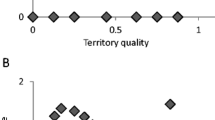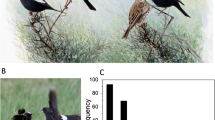Summary
Male ruffs (Philomachus pugnax), a lekking shorebird, can generally be divided into two morphs according to behavior and plumage coloration. Predominantly dark-colored, “independent” male ruffs defend small territories on a lek, whereas lighter colored “satellite” males are non-territorial and less site-faithful to a particular lek. The traits associated with the mating success of independent male ruffs were studied at two leks during two seasons on the island of Öland, Sweden in May and June of 1985 and 1987. Using multivariate analyses, three characteristics were found to be significantly related to mating success: high frequency of visits by satellites to an independent male's residence, consistency of lek attendance, and low rates of aggressive behavior. In contrast, mating success was unrelated to the degree of darkness of the independent male nuptial plumage, territory location on the lek, or rate of courtship displays. The use of multivariate analyses helped to resolve conflicting conclusions from previous studies which employed simple statistical analyses, or none at all. Experimental manipulations are suggested which will help to further determine the influence of female mate choice in this lekking system.
Similar content being viewed by others
References
Altmann J (1974) Observational study of behaviour. Behaviour 49:227–267
Andersen FS (1951) Contributions to the biology of the ruff (Philomachus pugnax (L.)). III. Dansk Orn Foren Tidsskr 45:145–173
Andersson M (1986) Evolution of condition-dependent sex ornaments and mating preferences: sexual selection based on viability differences. Evolution 40:804–816
Andersson S (1989) Sexual selection and cues for female choice in leks of Jackson's widowbird Euplectes jacksoni. Behav Ecol Sociobiol 25:403–410
Apollonio M, Festa-Bianchet M, Mari F (1989) Correlates of copulatory success in a fallow deer lek. Behav Ecol Sociobiol 25:89–97
Bateson PPG (1983) Mate choice. Cambridge University Press, Cambridge
Bradbury JW, Andersson MB (1987) Sexual selection: testing the alternatives. Wiley, New York
Bradbury JW, Gibson RM (1983) Leks and mate choice. In: Bateson PPG (ed) Mate choice. Cambridge University Press, Cambridge, pp 109–138
Castro G (1987) High metabolic rate in sanderlings (Calidris alba). Wilson Bull 99:267–268
Gibson R (1987) Bivariate versus multivariate analyses of sexual selection in red deer. Anim Behav 35:292–305
Gibson RM (1989) Field playback of male display attracts females in lek breeding sage grouse. Behav Ecol Sociobiol 24:439–443
Gibson RM, Bradbury JW (1985) Sexual selection in lekking sage grouse: phenotypic correlates of male mating success. Behav Ecol Sociobiol 18:117–123
Gibson RM, Bradbury JW (1986) Male and female mating strategies on sage grouse leks. In: Rubenstein DI, Wrangham RW (eds) Ecological aspects of social evolution: birds and mammals. Princeton University Press, Princeton, NJ, pp 379–398
Halliday TR (1987) Physiological constraints on sexual selection. In: Bradbury JW, Andersson MB (eds) Sexual selection: testing the alternatives. Wiley, New York, pp 265–277
Hamilton WD, Zuk M (1982) Heritable true fitness and bright birds: a role for parasites? Science 218:384–387
Hasson O (1989) Amplifiers and the handicap principle in sexual selection: a different emphasis. Proc R Soc Lend [Biol] 235:383–406
Heisler L, Andersson MB, Arnold SJ, Boake CR, Borgia G, Hausfater G, Kirkpatrick M, Lande R, Maynard Smith J, O'Donald P, Thornhill AR, Weissing FJ (1987) The evolution of mating preferences and sexually selected traits. In: Bradbury JW, Andersson MB (eds) Sexual selection: testing the alternatives. Wiley, New York, pp 96–118
Hogan-Warburg AJ (1966) Social behavior of the ruff Philomachus pugnax (L.). Ardea 54:109–229
Höglund J, Lundberg A (1987) Sexual selection in a monomorphic lek-breeding bird: correlates of male mating success in the great snipe Gallinago media. Behav Ecol Sociobiol 21:211–216
Hoglund J, Lundberg A (1989) Plumage color correlates with body size in the ruff (Philomachus pugnax). Auk 106:336–338
Kersten M, Piersma T (1987) High levels of energy expenditure in shore birds; metabolic adaptations to an energetically expensive way of life. Ardea 75:175–187
Kirkpatrick M (1982) Sexual selection and the evolution of female choice. Evolution 36:1–12
Kodric-Brown A, Brown JH (1984) Truth in advertising: the kinds of traits favored by natural selection. Am Nat 124:309–323
Lande R (1981) Models of speciation by sexual selection on polygenic traits. Proc Natl Acad Sci USA 78:3721–3725
Lank DB, Smith CM (1987) Conditional lekking in ruff (Philomachus pugnax). Behav Ecol Sociobiol 20:137–145
Matthiu PA, Johnson OW, Johnson PM, Whittow GC (1989) Basal metabolic rate of Pacific golden-plovers. Wilson Bull 101:652–654
McDonald DP (1989) Correlates of male mating success in a lekking bird with male-male cooperation. Anim Behav 37:1007–1022
O'Donald P (1980) Genetic models of sexual selection. Cambridge University Press, Cambridge
Oring LW (1982) Avian mating systems. In: Farner D, King J, Parkes K (eds) Avian biology, vol 6. Academic Press, New York, pp 1–92
Petterson J, Persson O, Hjort C (1986) Vadarpopulationerna vid Ottenby — status 1986 saint jämförelse med inventeringarna 1965–1979. Rapp Ottenby Fågelstn 9:1–52
Pitelka FA, Holmes RT, Maclean SF (1974) Ecology and evolution of social organization in arctic sandpipers. Am Zool 14:185–204
Pruett-Jones SG (1988) Lekking versus solitary display: temporal variations in dispersion in the buff-breasted sandpiper. Anim Behav 36:1740–1752
Pruett-Jones SG, Pruett-Jones MA, Jones HI (1990) Parasites and sexual selection in birds of paradise. Am Zool 30:287–298
Robertson JGM (1986) Female choice, male strategies, and the role of vocalizations in the Australian frog Uperoleia rugosa. Anim Behav 34:773–784
Ryan MJ (1985) The Túngara frog: a study in sexual selection and communication. Univeristy of Chicago Press, Chicago
Selous E (1906–1907) Observations tending to throw light on the question of sexual selection in birds; including a day-to-day diary on the breeding habits of the ruff (Machetes pugnax). Zoology 10:201–219, 285–294, 419–428; 11:60–65, 161–182, 367–381
Shepard JM (1975) Factors influencing female choice in the lek mating system of the ruff. Living Bird 87–111
Smithe FB (1975) Naturalist's color guide. American Museum of Natural History, New York
Sokal RB, Rohlf FJ (1981) Biometry. The principles and practice of statistics in biological research, 2nd edn. Freeman, San Francisco
Trail PW, Adams ES (1989) Active mate choice at cock-of-the-rock leks: tactics of sampling and comparison. Behav Ecol Sociobiol 25:283–292
van Rhijn JG (1973) Behavioural dimorphism in male ruffs, Philomachus pugnax (L.). Behaviour 47:153–229
van Rhijn JG (1983) On the maintenance and origin of alternative strategies in the ruff Philomachus pugnax. Behaviour 125:482–498
Whitfield DP (1986) Plumage variability and territoriality in breeding turnstone Arenaria interpres: status signalling or individual recognition? Anim Behav 35:1471–1482
Zahavi A (1975) Mate selection — a selection for a handicap. J Theor Bio 53:205–214[⋏]
Author information
Authors and Affiliations
Rights and permissions
About this article
Cite this article
Hill, W.L. Correlates of male mating success in the ruff Philomachus pugnax, a lekking shorebird. Behav Ecol Sociobiol 29, 367–372 (1991). https://doi.org/10.1007/BF00165962
Received:
Accepted:
Issue Date:
DOI: https://doi.org/10.1007/BF00165962




